Happy Chellappaswami Mahasamadhi!
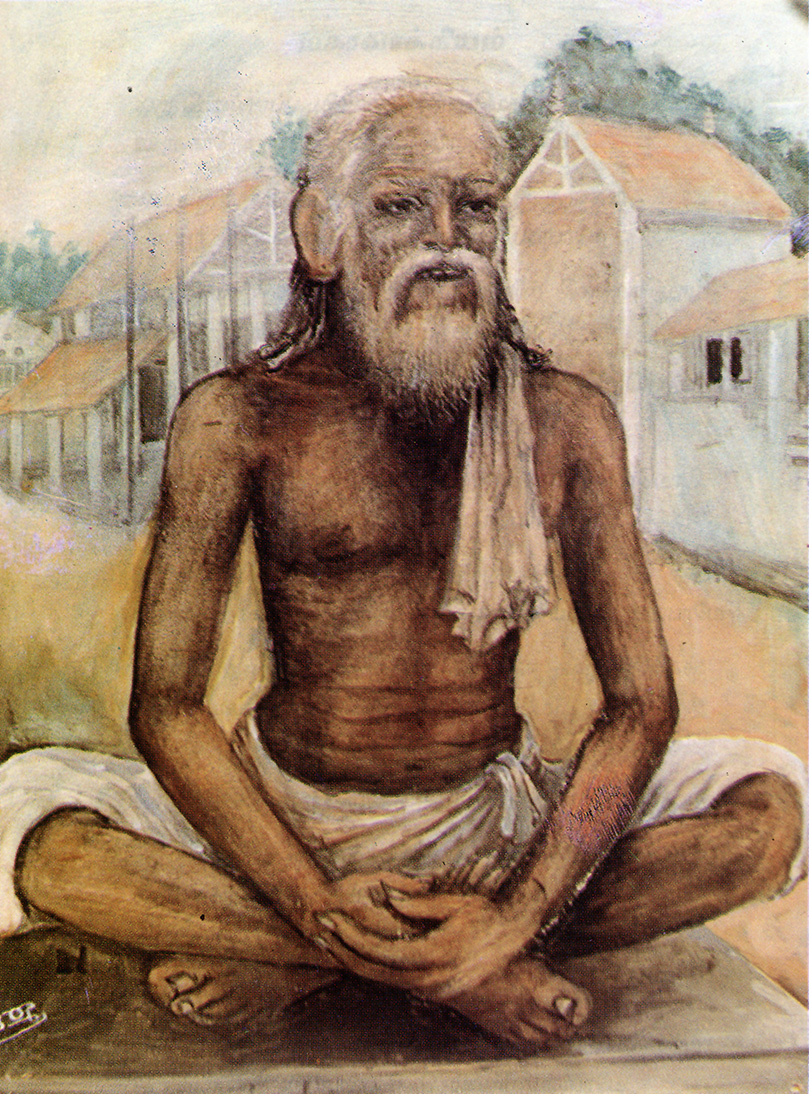
Jai Chellappaswami!
Yogaswami explained that most people try to get you to love them by giving you something you like so you will pay more attention to them; you transfer some of your attachment from the thing you like to the person who gave it to you. He told disciples, "Chellappaguru, through subtle guile, pulled me to his side by taking everything away. He did not allow me to put on any show, nor to do any service, nor to know the future, nor to have any siddhis, nor to associate with other saints or sadhus. He did not even allow me to wonder."
Chellappaswami spoke cryptically, in a language that had to be deciphered. Yogaswami himself recorded some of his gems:
"Intrinsic evil there is not," and "Absolute is Truth which none can ever comprehend"--so saying, he would remain mute. "It is what it is, and there is none who can know fully, as it is concealed in dissimulation"--so uttered the lofty Chellappan, clad in ragged clothes, and haunting Kandan's frontal courtyard. At those who frequent that resort, he will hurl abuse, my fond one.
"That is so from endless beginning," he would say and wander hither and thither. "It's all illusive phenomena," he muttered, "Who knows?" and "It was all settled long ago" and went about the outer courtyards of Nallur Temple and sat in the dirt, saying that all that dirt would frighten away the people who came to fall at his feet. I don't think anyone ever got from him an answer to a question. I merely stood and waited behind him for the occasional gem that fell out of all the mad talk.
Mrs. Inthumathy (Amma) Navaratnarajah shares this image of Chellappaswami and thoughtful insights into his guise of lunacy in her manuscript Yogaswami, Life and Teachings.
The great personage Chellappar sat on the chariot house step every day. Yet no divinity was visible on the dark-complexioned sadhu who sat with a vacant look on his face. Coarseness was the only visible sign. Even during festival times when the crowd was so dense that a ray of light would not pass through, he would sit on the step, his face shining, laughing to himself. Sometimes he would lie on the step, looking at decriers. Sometimes he would berate with belittling words those who were wandering about aimlessly. They would in turn abuse him, call him a lunatic and go away. He would not bother about this abuse and would continue to harangue them, taunting them to oppose him.
Sometimes he would stand in Lord Skanda's presence, before the sanctum, wearing rags, and scold in foul language those coming and going. At times he would wander to Tirunelveli, Columbuthurai and other places. People seeing him wander around would ridicule him as insane. He would stand begging before houses, accepting whatever was given. On some days he cooked rice and a curry. He did not sleep much. After midnight, using his hands as a pillow, he could be seen sleeping on the ground.
His versatility with his hands in weaving palmyra and coconut leaves into various objects of art was the only factor that showed that he was not mad. But is this one factor alone enough for the crazy world to realize his sanity?
Chellappaswami lived exhibiting the qualities of a madman and a great sage immersed in spiritual meditation. Those who were deluded by him considered him a madman. Those thirsting for spiritual knowledge saw him in his true colors--a man of deep knowledge. Siva Yogaswami saw him as the royal sage, who in the form of a guru redeemed and saved him. "At the teradi, I saw him, the crescent jewel of grace. He made me his own and showed me the way of bliss."
With these baffling disguises Chellappa wandered alone, hiding his real nature; so that no one realized his true self. Even scholars who were well-versed in Vedanta and Siddhanta, even those who had a long-standing friendship with him could not realize his true inner nature. Chellappa acted well the role of a lunatic he had taken on himself. Yogaswami once noted, "For forty years he acted the role he took without anyone suspecting, and went away."
Observing Sadhu Paksha
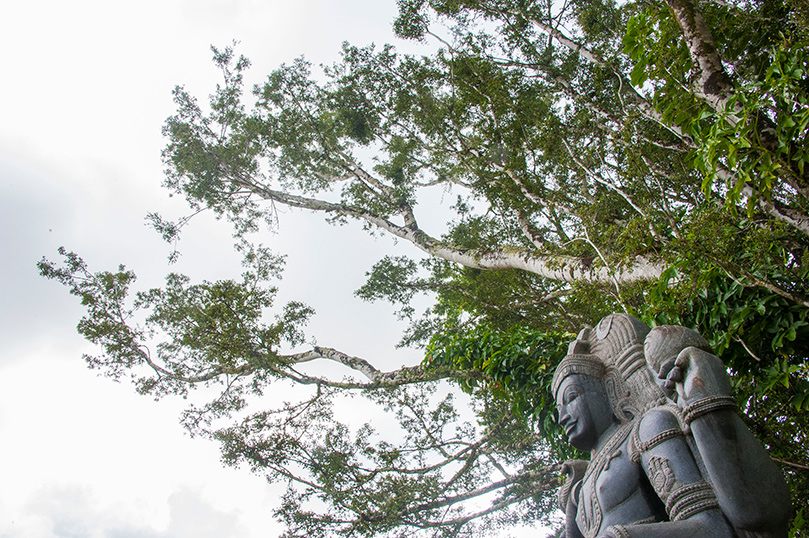
For the next two weeks, the monks of Kauai Aadheenam will be observing Sadhu Paksha. A time of retreat when the mathavasis break their normal, morning temple and meditation routines, to wonder through the sacred gardens in the early morning hours. In the morning quiet, they find a serene place in nature, a rock by the river, the top of a hill, or perhaps under a sacred tree. The gardens invite the monks to go within, amongst the peace of the flowing waters, the flutter of the windy leafs and the beauty of the early-morning bird songs. Coming out of mediation their eyes open to the warm light of the rising sun. Here are but a few of the sights that this time of year brings to the monastery's sacred gardens. Whatever you see, see as Śiva and do not be distressed, O mind! Those who are free from agitation and who the senses five control will surely win the bliss of Śiva. The path prescribed by your religion you should always tread, and live in changeless, silent contemplation. Whatever you see, see as Śiva. Siva Yogaswami
Media Studio Progress
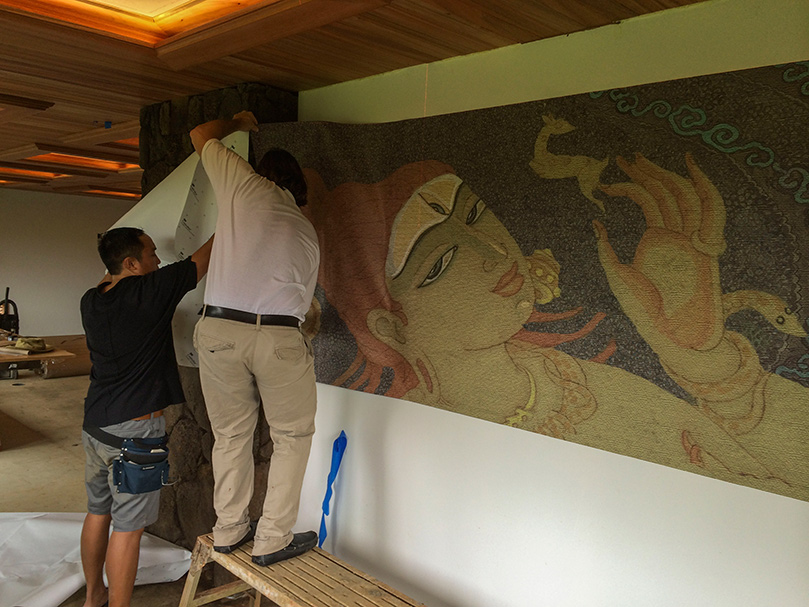
Today, the Media Studio's wallpaper is being installed. The artwork, originally created by S. Rajam, has been printed into giant murals by ARC Pacific on Oahu. The artwork is being put up by two skilled installers, Lyle and Mark. Most of the mural art will have wooden wainscoting installed beneath it, with a large redwood piece of trim above. Many other parts of the project are nearing completion as well. The finish stonework is moving along quickly, the vents and screens are being created put in place, the window shades have been installed, the exterior lighting is being completed and the rolls of vinyl flooring have arrived, ready to be installed in the coming week.
New Cows!

Today the Aadheenam's new cows arrived from the mainland. They are two, purebred jersey's, and one is said to be pregnant. We already have one jersey in our small herd, but the other three cows are holsteins. For those unaware, Holstein's are huge and can be rather aggressive, whereas jerseys are small, very gentle and have the richest milk. These two got off the boat today, and they're clearly happy to be here and ready for many relaxed days of munching down on our Kauai grasses.
Aloha Luncheon, May 10, 2014, You are invited
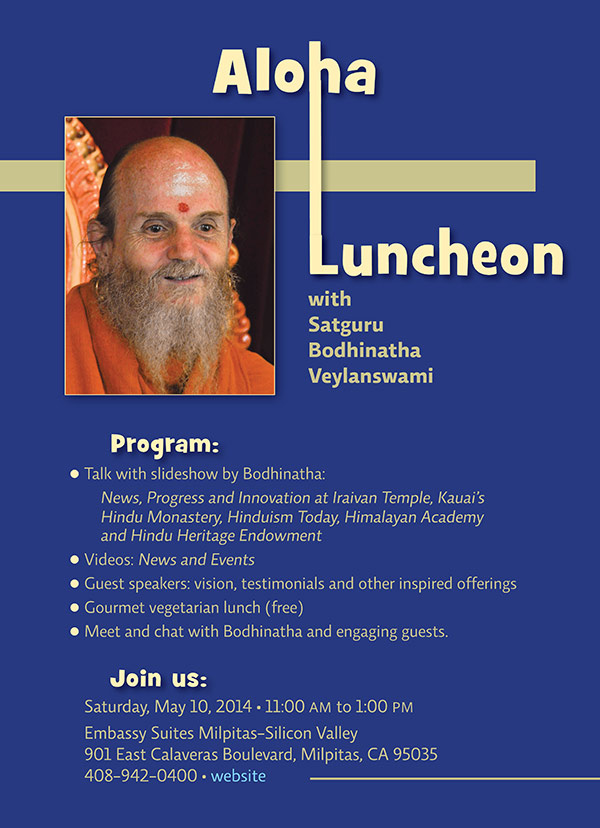
We are now putting together another great Aloha Luncheon for you. Come meet Bodhinatha, two of his swamis and about 100 supporters and friends of our monastery--among the most inspired and inspiring people on the planet.
Please consider joining us, even if you are far from California. Every year, some do travel great distances to attend and find it was well worth the effort.
Attendance is via RSVP (click here) only and space is limited, so please RSVP by May 1, 2014. For more info, please contact us at email jothi@hindu.org or 808-634-5407.
On the following day, in the same hotel, there will be another event, which you are also warmly invited to attend: a whole-day seminar led by Bodhinatha, again free of charge. Attend both events and be greatly uplifted. Again do contact us if you have any questions.
[Click here to go to the Embassy Suites Website]
Recent Visitors

In the first photo are Gurudatta and Saipriya Shamain from Arizona. They're connected with the Mahaganapati Temple there.
March 25th Homa
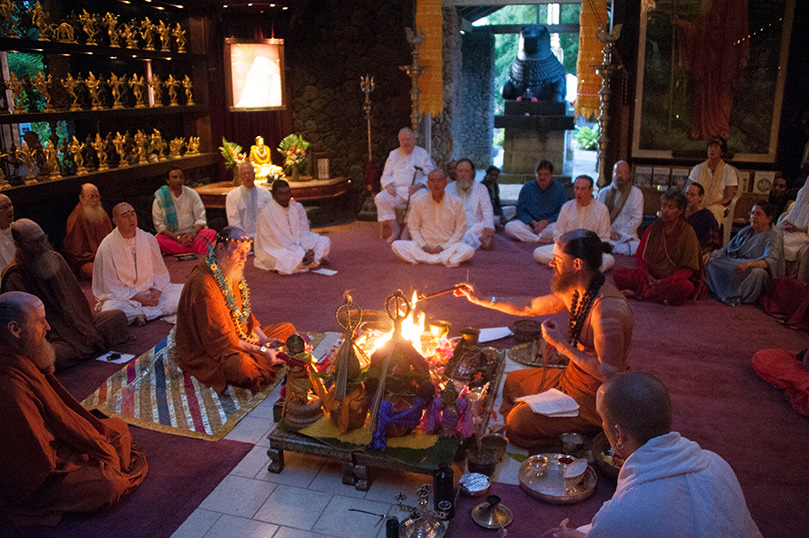
Today the monastery began its new phase with an early morning homa. This phase is a short one, of only four days, and it's followed by Sadhu Paksha. Sadhu Paksha is a time when the monks take a several week retreat, without the normal morning temple routine and instead practice their personal sadhanas. The two weeks are followed by the Ratau change. Today there were some new guests at the homa, all on pilgrimage to the aadheenam.
Following the homa, Satguru Bodhinatha read from Living with Siva lesson 344:
"I believe that this oldest religion of the farthest past is also the religion of the future, the religion best suited to the technological age. I think we should present Hinduism as it is today, as a vibrant religion of the present. Then it will survive into glorious futures. We need inspired people to serve Saivism with a strong will and a positive mind. In this effort, all differences must be set aside so we can work together on powerful programs that will bring progress; and that progress will inspire others, make them enthusiastic, show them that Saivism can be brought into the technological age for the good of the next generation, the next and the next.
What happens when a religion is lost in yesterday and not brought forward to guide its followers today and on into the future? All kinds of problems arise. The youth begin to think religion is obsolete, abandon it and become immersed in worldliness, often in activities that are adharmic. They leave the Saivite path, the Saiva Neri. Families break up, friends argue, and people fight within themselves and with one another. Poor citizens are raised in the absence of ethics. Unrest and discontentment reign, and the entire nation suffers. So many problems arise when religion is lost, when people don't know the right things to do. They become unhappy, restless, unstable. They have nothing to lean on, no place to turn in difficult times. This leads to abuse, to divorce, to suicide, to disease, to murder and dozens of sad experiences and hellish states of mind."
Then, in a very positive and inspiring way, Bodhinatha elaborated on the power of the temple and the ways in which Saivism is relevant to our current age of technology. We'll have this inspired talk online soon, available on our "Guru's Talks" page.
Twitter Update: Kauai's Hindu Monastery News Update http://t.co/Xt…
March 2014 News Video
Our March 2014 news video covers events in February 2014, including: The monastery's celebration of Mahasivaratri, Satguru Bodhinatha's travels to Trinidad and Texas, including his participation in the 2014 Midland Interfaith event, improvements to the monastery's vegetable gardens and new decor in Kadavul Temple.
German Edition of Gurudeva's Toolbox Online!
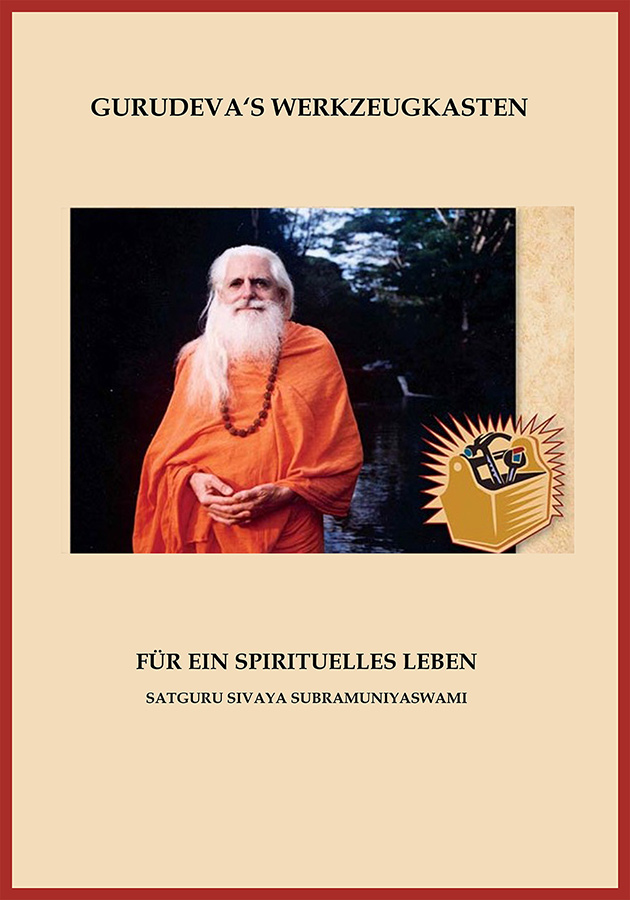
We are very happy to announce the release of the German edition of Gurudeva's Toolbox, translated by Professor Devarajan Sankaran. PDF, Kindle, Nook, ePub and Web viewing versions are available here: Gurudevas Werkzeugkasten. Thanks to our Digital Dharma Donors for their support which sponsors the cost of these productions.
Gurudeva's Werkzeugkasten für ein spirituelles Leben wurde von den Mönchen des Kauai Hindu Klosters anlässlich Gurudeva's Todestages 2005 als Andenken und zu Ehren seines Vermächtnisses und seiner Lehren zusammengestellt. Bei dem europäischen „Innersearch " Treffen verkündete er: „Ich habe Ihnen alle Werkzeuge zur Verfügung gestellt und es liegt an Ihnen, ob Sie sie nutzen oder nicht." Seine wesentlichen Lehren beinhalten eine vollständige Sammlung von Werkzeugen (Hilfsmitteln) und Vorgehensweisen, die den Fortschritt auf unserer spirituellen Reise bewirken. Er hat diese Methoden ab 1949 über eine Periode von 52 Jahren Praxis als Guru entwickelt. Er hat immer betont, daß es keine Notwendigkeit für zusätzliche Werkzeuge und Methoden gibt – die vorhandenen Werkzeuge sollten wirklich genutzt werden.
From Our Gurus' Teachings
Archives are now available through 2001. Light colored days have no posts. 1998-2001 coming later.
